The MultiFandomist
Life's Death
Dragon Breeds:
Bogsneak Dragons:
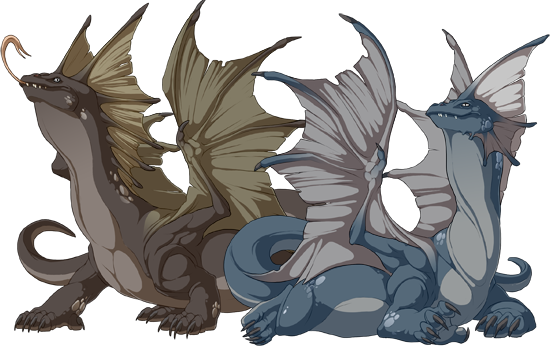
Rarity:
Diet:
Overview
Bogsneak dragons are elusive, clever creatures that spend a great deal of time hidden from view. The Bogsneak species is the result of an accidental synthetic genetic mutation. Adults that have undergone metamorphosis into a Bogsneak can pass that genetic information on to offspring.
Physical Attributes
Bogsneaks are a mid-sized breed. They are easily recognized by their impressive head-crests, the shape and number of which can vary widely. These swamp-dwellers have long, thick necks to support these fans, which can fan open or compress depending on temperature and mood. They have robust, powerful bodies and strong arm and leg muscles that can carry them across short distances very quickly. A long, prehensile tongue and rows of sharp razor-like teeth sit in a powerful jaw.
Secret of the Ooze: The Bogsneak mutagen was discovered by infamous Pearlcatcher alchemist Baldwin after a lightning strike accidentally electrified a composition within his cauldron. The incident caused Baldwin to be covered in the concoction, and over the course of several days, his DNA metamorphosed. Studies are ongoing into the long-lasting effects of the mutation, but it is possible for skilled alchemists to create their own strain for testing on themselves. The mixture will transform the receiving individual, and many have noted an increase in physical stamina, the ability to see better in the dark, and a negation age's effects. Once mutated, new Bogsneak dragons can successfully pass down these physical properties to offspring.
Social
It is not uncommon to find Bogsneak dragons completely isolated from others of their own kind, as they prefer to hunt or scavenge alone. When a pair are hunting in the same area, they are likely trying to race their counterpart to an unattended bird nest or arguing about who got there first. As a species they tend to focus on self-preservation over the communal good, especially when hungry.
Lairs
Bogsneak dragons purposely find the darkest, dampest corners of their natural environment, as far away as possible from others of their own kind, and especially other dragons species. These hunter-scavengers are staunchly solitary, with bonded mates sometimes even choosing their own separate places to huddle when not producing eggs. Bogsneak create their homes by ripping up shrubs and pulling rotten logs in around themselves.
Tactics
It is unlikely a foe will see a Bogsneak until it's too late, as they are extremely adept at hiding and (as their name portends) sneaking. Though preferring to explore or hunt alone, if a family group or clan is threatened, its members will literally gang up and "come out of the woodwork" to strike, then recede back into the brush to scurry to different location and strike again. Larger dragons now completely avoid walking through thick swamps and bogs, as it is a painful nuisance to be set upon a by defensive pack of Bogsneaks.
Coatl Dragons:
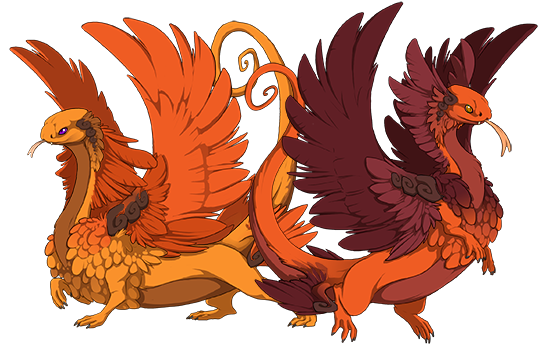
Rarity:
Diet:
Overview
The Coatl originate from Emberglow Hearth, where most of the species regularly migrate to nest among the warm ashfall.
Physical Attributes
Coatl dragons are a mid-sized breed with serpentine characteristics and beautiful, vibrant plumage. Their prehensile tail can be used to secure a perch or hold custom tools. Coatl are most commonly born in bright, chromatic colors, with both male and female coatl being equally flashy; there is little sexual dimorphism among the species. An unhealthy coatl can be identified by fading plumage. Dull colors are regarded by other coatl with sorrow and trepidation. Coatl who are naturally born grey or white are regarded as bad omens, and often exiled from nests to protect the rest of the clutch from catching illness or ill luck.
Social
These dragons are an agreeable lot, and attempt to placate enemies and competitors with small gifts of metal. This behavior has served them well, as cross-species communication suffers from much that is lost in translation. These communication problems stem from the unique way in which coatl perceive sound. They do not have a traditional ear structure, but are still able to discern and interpret vibrations in the air. Their hearing is not as keen as dragons with eardrums.
Coatl are one of the few species to have a native tongue. They hum a series of different pitches at varying intervals to communicate. The result is far from lovely to other dragon species, as sour notes and incomprehensible melody grates on their senses. Coatl can speak and interpret traditional draconic with difficulty, but have no capacity to understand the monotone fae species.
Lairs
Natural coatl lairs exist exclusively in the Ashfall waste. They are open-air affairs, with many sloping shelves carved close to the furnace-like heat of molten pools. Coatl dragons that migrate away from their homeland prefer to allow other dragon species to choose the shape and function of lairs, as they have very little knowledge of lair construction and maintenance. They make for polite, if oddly murmuring denmates.
Dragon species gain their elemental magic within the egg, imbued by the aura of the nearest deity. Coatl dragons are no exception to this, and one would think that as a result there would be a great variety in coatl elemental subtypes; however, this is not the case. Most coatl are tightly bound to the Flamecaller's forge, as coatl feel an instinctive drive to return to Emberglow hearth to raise their nests. This desire to brood in sweltering temperatures sees most coatl growing up with fire as the calling of the hatchling's magic. It takes a strong will for adult dragons to resist the urge to return "home" during mating season.
Tactics
When a gift will not settle a disagreement, a coatl is not shy about protecting itself or its clan. When a dispute cannot be settled peacefully, a coatl will transition from appeasement to combat in a split second, awarding them the first strike nine times out of ten. While other species generally regard coatl as a friendly species, they all agree that these dragons have a temper.
Fae Dragons:
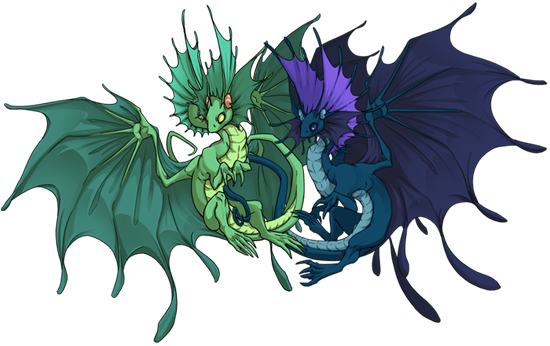
Rarity:
Diet:
Overview
Fae dragons are diminutive, highly active creatures. Their massive colonies boast populations that number in the tens of thousands. The Fae species originates from the Starwood Strand, but their rapid population growth has many colonies straying from their native homeland.
Physical Attributes
Fae Dragons are the smallest known dragon species, with larger individuals weighing up to 3kg. These tiny creatures have large wings and expressive crests that are used in communicating emotion and tone. Fae dragons have difficulty travelling long distances if there's not a constant source of insects available. As such, inter-domain journeys are massive undertakings.
Social
Fae dragons are social creatures within their own species. When interacting with other breeds they frequently have difficulty understanding emotion, as the lack of an expressive crest cripples the fae's ability to read the other dragon's intent. Equally, other species have difficulty reading the fae; the tiny dragons maintain a monotone when speaking and do not exhibit common body language.
Lairs
Fae dragons spin their roosts from tree sap that they cure with magic to become a beautiful golden amber. Their colonies are built on the sides of sheer cliffs or the trunks of massive trees, far out of the reach of other predators. Older colonies will often meet catastrophic ends, when the weight of too many dens takes the cliff side or tree down.
When fae dragons join with a mixed species clan, they will attempt to make a place for themselves in the larger dens. They carry as much tree sap with them as possible and spin their roost, weaving it into the inner walls of the shared den.
Tactics
Fae dragons fight their battles almost exclusively with magic and the inborn elemental powers of their flight. They work to turn their size to their advantage; a favored tactic of this species is to hide and rain down elemental destruction from a distance. To fight a fae in a battlefield of its choosing is a poor choice, one its enemies will not have the opportunity to make twice.
Fae are particularly sensitive to the magic of the world around them. While all dragonkind has the ability to harness internal and external magic, Fae dragons are known for their adeptness at channeling the lines of magic that crisscross the world. They frequently use the magic of the environment to supplement their own natural reserves. Fae dragons fighting on magically or elementally charged terrain will have a nearly infinite supply of energy to channel into their destructive spells. A fae that battles in a land charged with opposing elemental energy and no lines of unaligned magic will have only its natural reserves to draw upon, and will have to choose the spells it casts with care; the fae have smaller internal reserves of magic than most species.
Guardian Dragons:
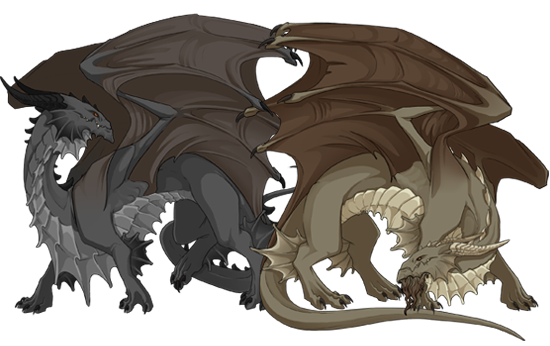
Rarity:
Diet:
Overview
Guardians are immense, protective creatures. The guardian species originates from Fishspine Reef, though the nature of The Search sees individuals wandering far from the birthplace of their race.
Physical Attributes
Guardian Dragons are one of the largest known dragon species. They have fins along their face, limbs, and chest. These rigid fins are armored, and can be held stiff or collapsed like fans. The fins can be flared outward to help protect the hide of the creature, making Guardians one of the most durable dragons in physical combat. Males of the species boast impressive beards that they go to great lengths to maintain.
Social
Guardians commonly live in small groups, though many prefer complete solitude. When a guardian becomes an adult, he or she will leave their birth clan and begin a journey that can span decades called The Search. This journey typically marks the last time that the new adult will ever see their original clan.
Dragon's Charge & The Search
When a Guardian dragon comes of age, it instinctively seeks out a charge to protect for the rest of its considerable life. Most Guardians do not know what its charge will be until they encounter it, and so it begins a journey. During this time it will wander tirelessly, seeking a worthy individual, object, or place to stand watch over. Once a Guardian discovers its charge, it begins its new life. It is then considered a true dragon by the rest of their species. A guardian without a charge is considered only half a dragon.
Guardian dragons see the failure to keep their chosen charge safe as a terrible blight to their honor, and most will pine away rather than live with the shame of their failure.
Lairs
Guardian dragons require a spacious location in which to carve out their den. Each lair is carved in a shape unique to the Guardian who will live there, the shape of the space owing more to the preferred movement and size of the guardian and less with visual aesthetics. Guardians create lairs near to their charge. If they are protecting a specific location, this will often mean that they live some distance away from their adoptive clan.
Tactics
The sheer size of the Guardian species awards them a place on the front lines of any skirmish. They wade into a battle without hesitation, using their tough armored fins and strong wings to protect themselves and the more fragile species that follow in their wake. Adults prefer to fight tooth and claw through most of their lives. As they age and become venerable, their typically small inner reserve of magic begins to grow and flare. Older members of the species use elemental augments to enhance each swing, rip, and thrust in battle.
Imperial Dragons:
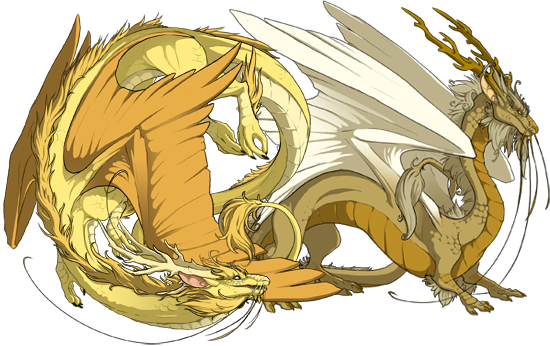
Rarity:
Diet:
The Imperial breed originated from The Beacon of the Radiant Eye, though the species seems conspicuously absent from its point of origin.
Physical Attributes
These giants are among the largest of the known dragons. Each imperial possesses a long serpentine body, short forelegs, lanky hind legs, and an impressive pair of fringed leather wings. With the exception of their wings and inner ears, Imperials are covered in shining scales from snout to tail. Each wyrm boasts a coarse mane that must be trimmed regularly, and a pair of many-pronged antlers that are shed and consumed each season.
Imperials were Light's first children, an amalgamation of bone, blood, and the shed essence of the Lightweaver - excavated from ancient battle sites of the First Age. This reclaimed essence was a finite resource; no new Imperials have been shaped by the gods in a millennia, though the species has no difficulty replenishing its numbers. These dragons have incredibly unpredictable lifespans. Some individuals live only a decade, while others thrive for hundreds of years.
Social
Reserved with their words, these dragons are difficult to read with those who are not familiar with each individual. Though distant emotionally, Imperials throw themselves into their Flight's cherished professions with focus and devotion. Perfection of a craft is highly valued among their society.
The treatment of the sick and the burial rites among Imperial dragons are something of a mystery to other dragon species. What is known is that when another Imperial is grievously injured or has recently passed, healthy imperials move the dead and dying far away from one another before leaving the territory themselves.
Lairs
Imperials prefer to associate with a only handful of their own kind at a time. Solitaries, pairs, and trios are the most common groupings of Imperial dragons to be found. This desire to distance themselves from their own kind does not extend to most other dragon species. They will freely lair with dragons of all shapes and sizes. The exception to this tolerance is the Pearlcatcher species; the two breeds have a mutual disdain of their cousin species. Imperials believe their creator has replaced them, while Pearlcatchers are conscious of the fact that their patron did not create them with the grandeur of scale of their predecessors.
Tactics
Though they are physically capable maintaining flight for weeks on end, Imperials are not as maneuverable as many smaller species, and are vulnerable in aerial combat. They will attempt to swat, grab, and drive their opponents to the ground where Imperials may better use their strength and magic against them.
Emperors
Emperor dragons are danger on a battlefield where many Imperials have fallen. These ghastly behemoths are a mindless monstrosity, fused from the bodies of fallen Imperials with some specimens known to have reached over 100 meters in length. They may possess up to 11 heads - the larger the emperor, the more heads it will possess. Each head is capable of wielding the element of the dragon that spawned it. These monsters destroy without thought and absorb elemental energy from the creatures and landscape surrounding it. Emperors are not to be trifled with. It may take the combined efforts of many clans to bring down an aberration of this magnitude; these dangerous opponents are one of the few creatures that may draw the gods from their shrines and onto a battlefield.
Mirror Dragons:
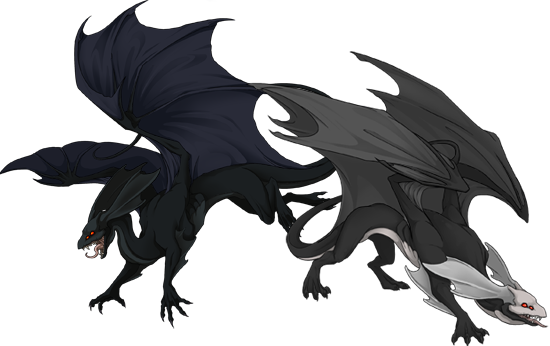
Rarity:
Diet:
Mirror dragons are known for their savagery and their hunger. They are social predators that run in immense packs. The species originates from The Abiding Boneyard, but their migratory nature sees packs roaming to every corner of the world.
Physical Attributes:
Mirror dragons are a medium-sized dragon that possesses two sets of eyes. The larger set allows them to see light, while the smaller forward-set pair allows them to track their prey by heat signature. Each mirror dragon has a rigid, fanned crest that is used in displays of dominance.
Mirrors are one of the few dragon species that prefer to do the bulk of their travel across the surface of the earth rather than over it. They are tireless on the land, running their prey down at sprint speeds of up to 50 miles an hour. These predators are capable of short-duration flights, but will quickly tire and return to earth. This may be due to their metabolism, which is a formidable beast; the average adult mirror will consume its body weight in prey each month.
Social:
Mirror dragons prefer to travel and hunt with their own kind, and do not mix well with other dragon species. They form transitory packs, made largely from whoever happens to be in the area at any given time. These leaderless packs merge, grow, and split constantly. A typical pack size ranges between 5-40 members. Lone mirrors by choice are an anomaly. A more typical encounter with a single mirror dragon occurs when an individual is injured or incapable of keeping up with the pack. Injured mirrors have been taken in and treated by other dragon species, but as soon as the mirror is physically capable they leave to rejoin the hunt.
Mirrors do not put much stock in chatter; that's not to say that they're incapable; most simply don't see the need. A dragon knows who its friends and allies are, and if one wants to communicate they should do so by action, not pithy words.
Lairs:
Mirror lairs are temporary occupied structures owned by no pack or clan. They are constructed from whatever material can be easily scavenged. These structures are abandoned when a pack has depleted all a hunting ground and moves onto a new territory. After the prey population in a depleted region has had a chance to recover, a new mirror pack may move into the vacated lair.
Tactics:
Mirror dragons prefer to keep any combat on the ground. While not particularly agile in the air, the speed and power of a pack of mirror dragons is a force to contend with.
Mirror "tactics" tend to be straightforward. If you see an enemy, kill it, and do so as quickly as possible. Most mirrors fight tooth and claw, though there are a handful of casters among their number.
Nocturne Dragons:
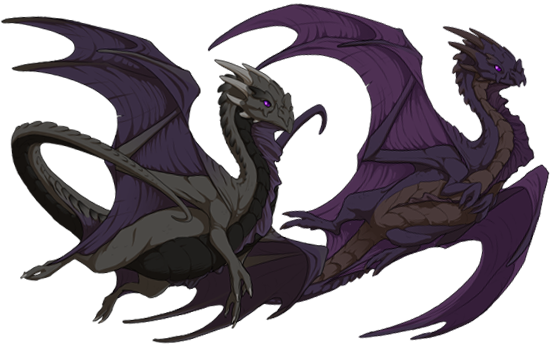
Rarity:
Diet:
Nocturne Dragons originate from deep within the Tangled Wood, where they are dormant for most of the year. They emerge for two weeks around the shortest day of winter to claim new territory and found new clans.
Physical Attributes
These bat-like dragons are stout and make use of an impressive wingspan to wrap themselves during the day, incubating their bodies. They are equipped with spines and horns that act as armor against the sharp thorns that cover plantlife in the Shadowbinder's domain. Although it is possible for Nocturne dragons to be active year-round in clans where they feel comfortable, the majority of unbound colonies remain staunchly hidden away and only surface to breed during the weeks following the Winter Solstice.
Social
Nocturnes are a species that adapts and mimics dragons they are in close proximity with; a nocturne who accompanies a guardian may adopt a temporary charge of their own, while a nocturne pestered by a spiral may become energetic and easily distracted. This mimicry does not extend exclusively to species characteristics, but to the individual personalities of their clanmates.
It is theorized that this behavior was once a tactic to ingratiate themselves among foreign clans, but over time has become an instinctive urge that delights and annoys those who come into contact with the species. Most individuals of this curious species loathe solitude. Nocturne who remain among their own kind frequently generate feedback loops. Their personalities and behaviors are passed from one individual to the next in an lengthy communal games of copycat.
Lairs
If given the chance to design their clan's lair, a nocturne will feel most secure by creating a hidden structure, constructed to camouflage with its surroundings. These dwellings are on the inside, but artful masterpieces indistinguishable from the environment on the outside. It is nearly impossible to visit a nocturne lair uninvited.
Tactics
Nocturne excel at subterfuge; they may falsify nearly-perfect battle orders, and are able to mimic the voices of their opponents.
However, they do not excel at physical confrontations. It is difficult to overcome the urge to copy one's opponent. Bolt is exchanged for bolt, strike for strike, and tactics are frequently ignored or forgotten. Opponents of a nocturne may use this to their advantage to encourage their foe into doing something rather stupid.
Pearlcatcher Dragons:
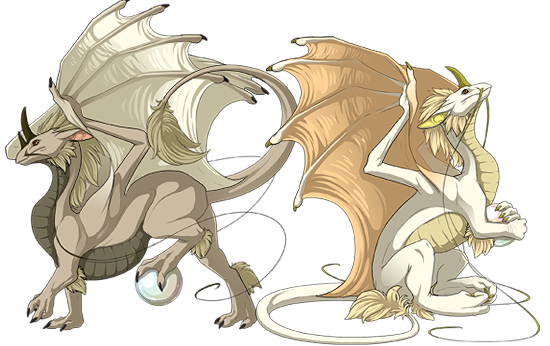
Rarity:
Diet:
Pearlcatcher dragons are haughty, independent creatures who consider themselves apart from the rest of dragonkind. The Pearlcatcher species originates from the Sunbeam Ruins, where their population continues to thrive.
Physical Attributes
Pearlcatchers are a mid-sized breed. Females possess a single, shining horn, while males have two. These dragons have compact bodies and leathery wings. A short, coarse mane runs down the length of their head and neck, and tufts of fur sprout from their elbows, ankles, and tail tips. Two long, sensitive whiskers grow from their muzzles, and they have large, mobile ears capable of independent movement.
Social
A Pearlcatcher knows its species to be the pinnacle of dragonkind, and each individual rests secure in the knowledge that they are at the top tier of that select species. Pearlcatchers are known for their love of gossip, choice tidbits and secrets of other dragons a currency among them worth more than mere gold.
Pearls:The most notable feature of a pearlcatcher dragon is the large, lustrous sphere carried with them at all times. After hatching, a young dragon will immediately consume its eggshell before its wings have had the chance to finish drying. Several hours later, they will regurgitate a large, lustrous pearl. They grow and maintain their pearl by secreting a thick, black mucus that cures to a smooth, iridescent sheen. Each new layer added to their pearl is believed to be the essence of what they've recently experienced, a memory made tangible and added to the whole of who they are.
Pearlcatchers regard their pearls as the vessel for their essence, and the most vital, important piece of themselves. A dragon that has lost its pearl believes that it has lost its identity. Pearl-less dragons are outcast from Pearlcatcher society, and must make their way in the world by begging succor from lesser dragon species.
Lairs
These dragons prefer to live in populated areas, establishing their territory in close proximity to other clans. In highly populated areas they may build their lairs directly atop of those of allied clans, creating elaborate, many-tiered structures with a mish-mash of architectural design. Clans each have a signature style; social snubs can lead to midnight vandalism, the rival clan "gifting" their nemesis with a new piece of architecture, permanently affixed to their lair.
Tactics
Pearlcatchers are notorious cowards, and prefer flight to fight. An offer of current gossip is often used as a bartering chip to avoid confrontation.
If presented with a situation where they have an overwhelming advantage over a much-hated foe, they will hover from a safe distance and attack their enemies with long-range magical attacks. The moment this distance seems likely to be closed, they will attempt to flee.
Ridgeback Dragons:
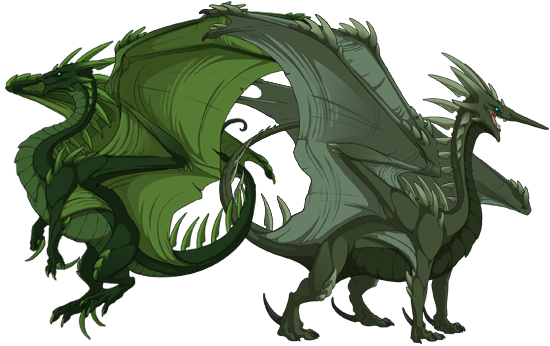
Rarity:
Diet:
Ridgebacks are massive, cunning dragons. The Ridgeback breed originates from The Shifting Expanse, and most of their species still calls this territory home. A small number have begun to venture out into the world, but their eccentric tendencies and specialized diet have most clans turning them away.
Physical Attributes
The Ridgeback is an imposing dragon, towering meters above other species. Male Ridgebacks possess a large, forward-facing horn that continues to grow throughout the dragon's life. They have sharp, ridged spines running down the length of their body and limbs. These spines are molted each turn. When their mane of spines rejuvenates it's an itchy and time-consuming process. It's wise to tread lightly around a half-spined dragon, as their temper during these times is not at its finest.
These dragons will spend hours baking in the sun, and polish their scales to a glistening sheen by rolling around in the coarse desert sands. Ridgeback aversion to water is legendary, which is ironic given their diet.
Social
Ridgeback society revolves around borrowing. While other dragons might call this stealing, Ridgebacks think borrowing is a normal and necessary facet of life. The Shifting Expanse is an inhospitable homeland, and the cunning Ridgeback learned early-on that it was better to borrow than starve.
These crafty giants use their wits and tunneling abilities to borrow from neighboring territories. Ore is pulled from deep below the enriched ground of the Ashfall Waste, the bounty of the Sea of a Thousand Currents harvested in traps, and miles of subterranean pumps siphon fresh water from the neighboring Sunbeam Ruins. If caught red-handed in the midst of these resource-accumulations, a Ridgeback will simply shrug their spines and claim that they were just borrowing it: If you wanted it back all you had to do was ask!
This tendency to borrow first, ask later does not merely apply to the bare necessities. Ridgeback dragons freely borrow from one-another, the constant back-and-forth borrowing of the same items over and over a game, and the foundation of their relationships.
Lairs
Ridgebacks prefer subterranean lairs carved from sandstone. These giants are adept at tunneling. They will seek to expand their lairs daily if able, the act of tunneling an enjoyable activity. Mixed-species lairs often see other dragon species moaning over the constant scraping cacophony of a tunneling Ridgeback.
Tactics
If pressed into battle, a Ridgeback will close the distance, crashing into their foe and using their wicked spines to carve them up. It is difficult to find a safe purchase on an enraged Ridgeback. These giants prefer to fight alone; close formations tend to create as many damaged friends as foes.
Skydancer Dragons:
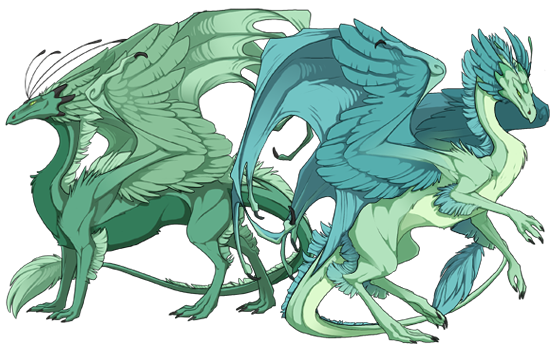
Rarity:
Diet:
Skydancer dragons originate from The Reedcleft Ascent, a region that continues to boast the largest concentrated population of the species.
Physical Attributes
Skydancers are a small-to-mid size dragon breed with a lithe frame, long legs, serpentine neck, and a long tail. These dragons are covered by a silky hide of short fur that becomes longer and denser along the spine and legs. Brilliantly colored feathers adorn their wings and form a crest around their face.
The most unusual feature of this species is the translucent bony sphere located in the center of their forehead. This gem-like orb connects directly to the skydancer's skull and the delicate antennae surrounding it are sensitive to minute vibrations. This ability allows the species to sense when magical energies are present, and to sense the disposition of other dragons and creatures by the subtle energy given off by their body and state of mind.
Social
Individuals of this species are frequently chosen to mediate clan disputes. Their ability to read energy and emotion makes them excellent at questioning feuding clan members and ferret out the truth of a situation. This ability is not without its weaknesses; some dragons may have energy and emotions that are difficult to read. Unscrupulous individuals with something to hide and foreknowledge that a skydancer will be questioning them may imbibe a concoction of herbs intended to alter their own energy and confound a skydancer's senses.
Like their spiral cousins, skydancers are an active species. They enjoy channeling their energy into elaborate dances and displays of aerial acrobatics.
Lairs
The gentle nature of Skydancers enables them to work and socialize well with other dragon breeds. They prefer to live in large clans if possible, and will actively encourage growth and expansion in any clan smaller than several hundred members.
Skydancer clutches must be petitioned and discussed among the entire clan. Skydancers are dedicated parents. Their attention is focused on the care and rearing of their young to the exclusion of all else until their hatchlings are fully fledged. A carefully planned hatchery rotation ensures that the clan can still function as its members take time off to care for their families. The nests of Skydancers are festooned with a variety of trinkets and baubles to delight and entertain the hatchlings.
Tactics
Members of this species prefer to act as scouts and collect intelligence for their clan over directly participating in a melee or major casting. A skydancer's energy awareness allows them to sense other dragons and magical workings from a distance making them the ideal forerunner to any warband. While they can sense a general location or direction of energies, pinpointing the precise location of energy signatures often requires getting closer than is comfortable. An added hurdle for scouting skydancers is that rival clans may also employ this species as scouts of their own, resulting in extended games of cat and mouse.
Snapper Dragons:
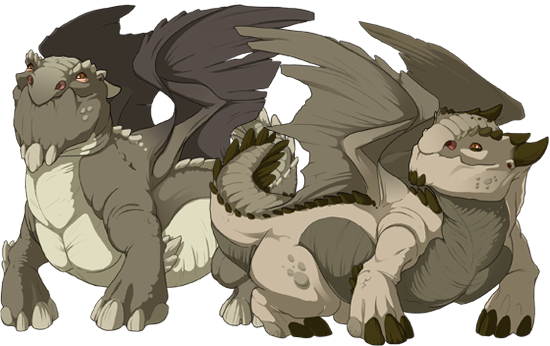
Rarity:
Snappers are wise, thoughtful dragons. The snapper species originates from The Shattered Plain , where the majority of the population still resides.
Physical Attributes
Snapper dragons are built solidly and low to the ground. Their impressive beaks are lined with molars that begin halfway down the jaw and continue all the way to the back. They are well suited for the environment of their native homeland. A land-bound species, their thick, blunted nails enable them to break through the shale of the Shattered Plains to the shallow wells of water that can occasionally be found below the surface, making survival in this harsh land possible. Here, they thrive. While it is uncommon for a Snapper to leave Dragonhome, many individuals have shifted their migratory routes into neighboring territories.
Social
These dragons are nomadic, methodically following ancient, looping paths known only to their clan across the featureless plains. A snapper does not sleep and rarely stops moving. Snappers are living encyclopedias. A dragon who is seeking difficult-to-obtain information will have the most luck unearthing it from a Snapper clan - provided they have the patience for it. If you want two dozen quick answers, talk to a spiral. If you want a fully developed novel, follow a troupe of Snappers around for a week.
Lairs
With the the majority of their lives spent in travel, these dragons do not build permenant lairs. Snappers have difficulty residing in closed spaces or living in small, restricted territories. They do not do well in mixed-species lairs, and typically leave after a short duration. One to four times a year, (depending on the age and size of the dragon), a Snapper will create a shallow burrow and spend several days molting. After emerging, they will pick up where they left off on their route.
Tactics
Snappers do not seek confrontation, but when it presents itself they prefer a direct response. Their standard tactics involve trampling smaller foes beneath their bulk or using their powerful jaws to snap them out of the air. The crushing force of their beak is enough to shatter the scales and armored plating of most species. When confronted with overwhelming odds, Snappers will lower themselves to the ground, protecting their underbellies. Their back and sides are protected by a thick, rugged hide that is difficult to pierce. They attempt to outlast attacks made against them (and frequently succeed in their endeavours) until help can arrive. It is difficult to move an entrenched Snapper with anything but an opposing elemental attack.
Spiral Dragons:
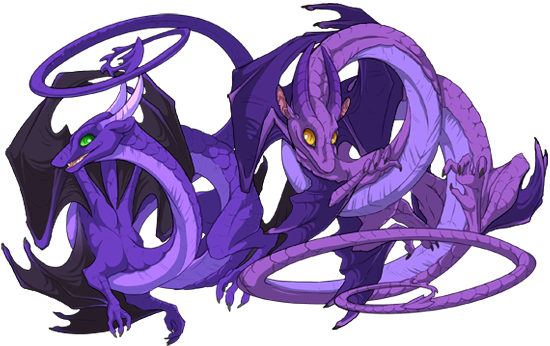
Rarity:
Diet:
Spiral dragons are sinuous, active creatures. They are best known for their erratic flight patterns and energetic nature. This species originates from the Zephyr Steppes where their population continues to thrive.
Physical Attributes
Spiral dragons have the greatest length-to-size ratio of any known species. Their sinuous lengths are incredibly flexible and may twist and contort into any number of impossible shapes, though the most common flight pattern involves a looping spiral. The small wings on their arms and legs help provide some control to their otherwise chaotic flights. Spirals have large, sensitive eyes that they use to their advantage during their nocturnal hunting.
Social
It is said that spirals possess only two states of being: unconscious, and full tilt. Spiral dragons have difficulty focusing on one thing at a time, but are excellent at multi-tasking a myriad of simultaneous thoughts and activities that would disorient other dragon species. A spiral without anything to keep it occupied is capable of literally tying itself into knots in agitation.
Frequent naps between their bursts of enthusiasm are necessary. It is not uncommon for a spiral dragon to rapidly speak and gesture nonstop for hours, then pass-out midsentence without warning. Their ropey lengths instinctively wrap and coil around any available surface even in slumber. This adaptation has kept many spirals from meeting an unfortunate end.
Lairs
Spiral dragons prefer to build their lairs inside of trees or mighty fungi. They will burrow deep, winding tunnels within the living wood, often killing the host tree in the process. A spiral clan is capable of decimating large swathes of ancient forest.
Within mixed-species clans, spiral dragons will seek out locations inside the foreign lair that they can make their own. Any cracks present in rock, pipes, or places where they can create passages just wide enough to allow their ropelike bodies to squeeze into become thin, spiraling labyrinths. These delicate tunnels will often undermine the strength of lairs carved from stone.
Tactics
Spiral dragons fight their battles with quick-cast spells. They rely on their natural agility to protect them from oncoming attacks. Their erratic, unpredictable flight patterns make them a difficult target to hit. If a spiral dragon injures any one of its six wings, the fight is over.
Tundra Dragons:
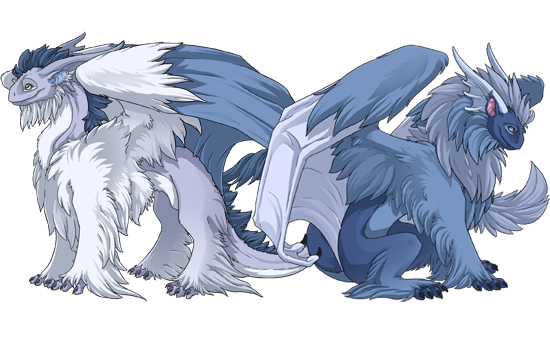
Rarity:
Diet:
The Tundra species originated from the Snowsquall Tundra. Though not the the brightest of creatures, this hardy breed survives by virtue of their toughness and ability to eat almost anything that grows. Their constitution allows them uncontested domain over harsh, barren tracts of land that other dragons are pleased to avoid.
Physical Attributes
The most striking feature of the Tundra dragons is their thick, shaggy coat of fur*. As winter approaches their coats become incredibly dense and spreads to cover the entire dragon. Flight with a full winter coat is difficult and only undertaken in times of need. During the summer season tundra dragons shed their winter coats, leaving their body covered in a much finer coat of fur, the hindquarters and lower wings exposed.
Tundra dragons who join flights in warmer climes never see their winter coats (though their summer coat is more than enough to cause heat exhaustion in locations such as the Viridian Labyrinth, Ashfall Waste, and Shifting Expanse). Tundra dragons possess impressive canine teeth used for combat. The majority of their jaw is set with flat, wide molars, perfect for grinding up scrub.
Social
Tundra dragons form deep bonds within their family groups, and are loathe to leave their birth clan. They are not a chatty species, though they enjoy the company of others. Companionable silence is welcome, as is simply listening to other dragons' tales.
Tundras have difficulty remembering names, faces, and specific details about dragons that they have not seen in over a season. Despite this, their olfactory memory is excellent. "You smell like a friendship." is a common greeting between tundra dragons who have not seen one another in years, the names and details of their association forgotten. When encountering a dragon who smells like friendship, tundras typically attempt to become friends again. This "friend-again" may present an awkward situation for a dragon of a different species. The tundra treats the relationship as if they were meeting for the first time, introducing themselves and asking questions that have likely been rehashed many times before.
In the same manner, tundra dragons remember individuals who wronged them by smell alone. "You smell like an enemy." can result in feuds between clans that span centuries, the exact reason for their squabbling long-forgotten.
Lairs
Tundras are natural burrowers. In warmer climes the burrow presents a cool refuge from hot winds and beating sun. These burrows are elaborate underground mazes, with interconnected chambers created for each mated pair or family. The chambers and passages of the burrow are shored-up with branches and trunks stripped clean of their foliage. (a delicious but difficult undertaking!)
Tundra dragons graze daily during spring, summer, and autumn. The flock travels great distances each day to find fresh feeding grounds, taking great care not to overgraze any particular stretch of land. A small number of dragons remain behind to oversee the lair and any hatchlings too young to make the journey. These individuals rotate their duty day-to-day so that all members of the clan have a chance to feed. A few unruly hatchlings in every clan use this "changing of the guard" to their advantage, making all manner of mischief against their unwitting guardians.
Tactics
Tundra dragons go to great lengths to avoid combat, shrugging off blows and readily agreeing to get out of the way; however, if a member of their clan is in true peril the flock will cluster together presenting a unified front. Breath attacks are the favored weapon of the Tundra. Flocks instinctively coordinate their breath attacks in perfectly timed waves, leaving few gaps of time in which the air is not filled with a wall of their element.
Wildclaw Dragons:
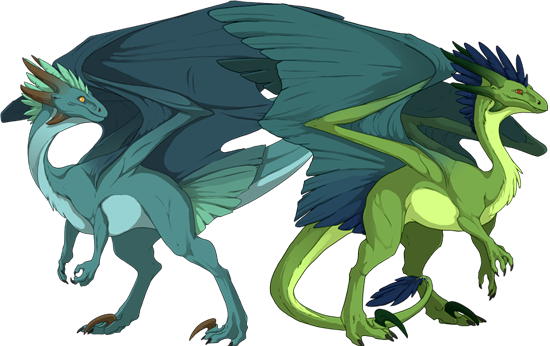
Rarity:
Diet:
The Wildclaw breed originates from Shrieking Wilds where its population remains abundant. This species has begun to expand into new domains, the most notable of which is The Wandering Contagion. This territory supports the second largest population of Wildclaw dragons, which some consider to be unusual given the homeland of the species. To say that these two regional groups do not get along is an understatement, and most encounters between the two populations trend towards bloodshed.
Physical Attributes:
Wildclaw are a bipedal species of dragon. Their powerful hind legs excel at launching them into the air and enabling them to slash at their prey. The shorter front legs possess dexterous claws and opposable thumbs. Wildclaws display little sexual dimorphism, with both male and females possessing a crown of six horns and a crest of feathers. Females of the species are on-average slightly larger than their male counterparts.
Social:
Wildclaw hierarchy revolves around physical might and hunting prowess. A dragon's station is dictated by their ability to provide for the clan, with the best hunters and fighters being awarded positions of power. Dragons may challenge those who have offended them to a duel, no matter how small or fabricated the infraction. Truly a society of "might makes right", arguments that can't be won with logic may be won with tooth and claw. To decline a duel is to admit that one was in the wrong, for the truth of one's words is something worth fighting for. Declining a duel will lower a wildclaw's position in the clan far more than losing a duel, though participating in the duel comes with the risk of losing one's life.
Lairs:
Wildclaw lairs are colorful and ornamented. Dragons who are of lower ranking are encouraged to take up professions that allow them to beautify and enhance the dwelling of the clan. Chambers of the upper echelons of wildclaw society are covered in intricate murals depicting the past victories of the occupants. These walls are stripped and repainted whenever there is movement in the hierarchy, much to the grief of the artists.
Nests are sequestered away from the clan lair. A large family tree is considered prestigious; rivals have been known to pilfer and rear the eggs of their enemies to grow the branches of their family tree more swiftly. Choosing a strong mate is important for incubation and rearing of any clutch. In each pairing the dragon with the greatest physical prowess is given the honor of brooding over the nest until it hatches, while its partner is required to scout the surrounding territory for enemies and provide for their family. When hatchlings have fully imprinted upon their parents, the family will move back into the clan's lair.
Tactics:
Wildclaws hunt and fight alone or in pairs. Those who are bonded to a dragon of a different species will always fight alone. Some theorize this is to protect their physically inferior (but no doubt lovable) partner by keeping dangers at a safe distance from them. While Wildclaw are adept at silent movement on the ground, when confronting another dragon they will address the enemy head-on by flaring their wings and shrieking their challenge.
I understand if this is a lot to read, but it is essential for you to know as much as you can about the Breeds for Roaring Skies.
Bogsneak Dragons:

Rarity:
- Uncommon
Diet:
- Plants
- Meat
Overview
Bogsneak dragons are elusive, clever creatures that spend a great deal of time hidden from view. The Bogsneak species is the result of an accidental synthetic genetic mutation. Adults that have undergone metamorphosis into a Bogsneak can pass that genetic information on to offspring.
Physical Attributes
Bogsneaks are a mid-sized breed. They are easily recognized by their impressive head-crests, the shape and number of which can vary widely. These swamp-dwellers have long, thick necks to support these fans, which can fan open or compress depending on temperature and mood. They have robust, powerful bodies and strong arm and leg muscles that can carry them across short distances very quickly. A long, prehensile tongue and rows of sharp razor-like teeth sit in a powerful jaw.
Secret of the Ooze: The Bogsneak mutagen was discovered by infamous Pearlcatcher alchemist Baldwin after a lightning strike accidentally electrified a composition within his cauldron. The incident caused Baldwin to be covered in the concoction, and over the course of several days, his DNA metamorphosed. Studies are ongoing into the long-lasting effects of the mutation, but it is possible for skilled alchemists to create their own strain for testing on themselves. The mixture will transform the receiving individual, and many have noted an increase in physical stamina, the ability to see better in the dark, and a negation age's effects. Once mutated, new Bogsneak dragons can successfully pass down these physical properties to offspring.
Social
It is not uncommon to find Bogsneak dragons completely isolated from others of their own kind, as they prefer to hunt or scavenge alone. When a pair are hunting in the same area, they are likely trying to race their counterpart to an unattended bird nest or arguing about who got there first. As a species they tend to focus on self-preservation over the communal good, especially when hungry.
Lairs
Bogsneak dragons purposely find the darkest, dampest corners of their natural environment, as far away as possible from others of their own kind, and especially other dragons species. These hunter-scavengers are staunchly solitary, with bonded mates sometimes even choosing their own separate places to huddle when not producing eggs. Bogsneak create their homes by ripping up shrubs and pulling rotten logs in around themselves.
Tactics
It is unlikely a foe will see a Bogsneak until it's too late, as they are extremely adept at hiding and (as their name portends) sneaking. Though preferring to explore or hunt alone, if a family group or clan is threatened, its members will literally gang up and "come out of the woodwork" to strike, then recede back into the brush to scurry to different location and strike again. Larger dragons now completely avoid walking through thick swamps and bogs, as it is a painful nuisance to be set upon a by defensive pack of Bogsneaks.
Coatl Dragons:

Rarity:
Diet:
- Seafood
Overview
The Coatl originate from Emberglow Hearth, where most of the species regularly migrate to nest among the warm ashfall.
Physical Attributes
Coatl dragons are a mid-sized breed with serpentine characteristics and beautiful, vibrant plumage. Their prehensile tail can be used to secure a perch or hold custom tools. Coatl are most commonly born in bright, chromatic colors, with both male and female coatl being equally flashy; there is little sexual dimorphism among the species. An unhealthy coatl can be identified by fading plumage. Dull colors are regarded by other coatl with sorrow and trepidation. Coatl who are naturally born grey or white are regarded as bad omens, and often exiled from nests to protect the rest of the clutch from catching illness or ill luck.
Social
These dragons are an agreeable lot, and attempt to placate enemies and competitors with small gifts of metal. This behavior has served them well, as cross-species communication suffers from much that is lost in translation. These communication problems stem from the unique way in which coatl perceive sound. They do not have a traditional ear structure, but are still able to discern and interpret vibrations in the air. Their hearing is not as keen as dragons with eardrums.
Coatl are one of the few species to have a native tongue. They hum a series of different pitches at varying intervals to communicate. The result is far from lovely to other dragon species, as sour notes and incomprehensible melody grates on their senses. Coatl can speak and interpret traditional draconic with difficulty, but have no capacity to understand the monotone fae species.
Lairs
Natural coatl lairs exist exclusively in the Ashfall waste. They are open-air affairs, with many sloping shelves carved close to the furnace-like heat of molten pools. Coatl dragons that migrate away from their homeland prefer to allow other dragon species to choose the shape and function of lairs, as they have very little knowledge of lair construction and maintenance. They make for polite, if oddly murmuring denmates.
Dragon species gain their elemental magic within the egg, imbued by the aura of the nearest deity. Coatl dragons are no exception to this, and one would think that as a result there would be a great variety in coatl elemental subtypes; however, this is not the case. Most coatl are tightly bound to the Flamecaller's forge, as coatl feel an instinctive drive to return to Emberglow hearth to raise their nests. This desire to brood in sweltering temperatures sees most coatl growing up with fire as the calling of the hatchling's magic. It takes a strong will for adult dragons to resist the urge to return "home" during mating season.
Tactics
When a gift will not settle a disagreement, a coatl is not shy about protecting itself or its clan. When a dispute cannot be settled peacefully, a coatl will transition from appeasement to combat in a split second, awarding them the first strike nine times out of ten. While other species generally regard coatl as a friendly species, they all agree that these dragons have a temper.
Fae Dragons:

Rarity:
Diet:
- Insects
Overview
Fae dragons are diminutive, highly active creatures. Their massive colonies boast populations that number in the tens of thousands. The Fae species originates from the Starwood Strand, but their rapid population growth has many colonies straying from their native homeland.
Physical Attributes
Fae Dragons are the smallest known dragon species, with larger individuals weighing up to 3kg. These tiny creatures have large wings and expressive crests that are used in communicating emotion and tone. Fae dragons have difficulty travelling long distances if there's not a constant source of insects available. As such, inter-domain journeys are massive undertakings.
Social
Fae dragons are social creatures within their own species. When interacting with other breeds they frequently have difficulty understanding emotion, as the lack of an expressive crest cripples the fae's ability to read the other dragon's intent. Equally, other species have difficulty reading the fae; the tiny dragons maintain a monotone when speaking and do not exhibit common body language.
Lairs
Fae dragons spin their roosts from tree sap that they cure with magic to become a beautiful golden amber. Their colonies are built on the sides of sheer cliffs or the trunks of massive trees, far out of the reach of other predators. Older colonies will often meet catastrophic ends, when the weight of too many dens takes the cliff side or tree down.
When fae dragons join with a mixed species clan, they will attempt to make a place for themselves in the larger dens. They carry as much tree sap with them as possible and spin their roost, weaving it into the inner walls of the shared den.
Tactics
Fae dragons fight their battles almost exclusively with magic and the inborn elemental powers of their flight. They work to turn their size to their advantage; a favored tactic of this species is to hide and rain down elemental destruction from a distance. To fight a fae in a battlefield of its choosing is a poor choice, one its enemies will not have the opportunity to make twice.
Fae are particularly sensitive to the magic of the world around them. While all dragonkind has the ability to harness internal and external magic, Fae dragons are known for their adeptness at channeling the lines of magic that crisscross the world. They frequently use the magic of the environment to supplement their own natural reserves. Fae dragons fighting on magically or elementally charged terrain will have a nearly infinite supply of energy to channel into their destructive spells. A fae that battles in a land charged with opposing elemental energy and no lines of unaligned magic will have only its natural reserves to draw upon, and will have to choose the spells it casts with care; the fae have smaller internal reserves of magic than most species.
Guardian Dragons:

Rarity:
Diet:
- Meat, Seafood, Insects, Plants
Overview
Guardians are immense, protective creatures. The guardian species originates from Fishspine Reef, though the nature of The Search sees individuals wandering far from the birthplace of their race.
Physical Attributes
Guardian Dragons are one of the largest known dragon species. They have fins along their face, limbs, and chest. These rigid fins are armored, and can be held stiff or collapsed like fans. The fins can be flared outward to help protect the hide of the creature, making Guardians one of the most durable dragons in physical combat. Males of the species boast impressive beards that they go to great lengths to maintain.
Social
Guardians commonly live in small groups, though many prefer complete solitude. When a guardian becomes an adult, he or she will leave their birth clan and begin a journey that can span decades called The Search. This journey typically marks the last time that the new adult will ever see their original clan.
Dragon's Charge & The Search
When a Guardian dragon comes of age, it instinctively seeks out a charge to protect for the rest of its considerable life. Most Guardians do not know what its charge will be until they encounter it, and so it begins a journey. During this time it will wander tirelessly, seeking a worthy individual, object, or place to stand watch over. Once a Guardian discovers its charge, it begins its new life. It is then considered a true dragon by the rest of their species. A guardian without a charge is considered only half a dragon.
Guardian dragons see the failure to keep their chosen charge safe as a terrible blight to their honor, and most will pine away rather than live with the shame of their failure.
Lairs
Guardian dragons require a spacious location in which to carve out their den. Each lair is carved in a shape unique to the Guardian who will live there, the shape of the space owing more to the preferred movement and size of the guardian and less with visual aesthetics. Guardians create lairs near to their charge. If they are protecting a specific location, this will often mean that they live some distance away from their adoptive clan.
Tactics
The sheer size of the Guardian species awards them a place on the front lines of any skirmish. They wade into a battle without hesitation, using their tough armored fins and strong wings to protect themselves and the more fragile species that follow in their wake. Adults prefer to fight tooth and claw through most of their lives. As they age and become venerable, their typically small inner reserve of magic begins to grow and flare. Older members of the species use elemental augments to enhance each swing, rip, and thrust in battle.
Imperial Dragons:

Rarity:
Diet:
- Insects
- Meat
- Seafood
- Plants
The Imperial breed originated from The Beacon of the Radiant Eye, though the species seems conspicuously absent from its point of origin.
Physical Attributes
These giants are among the largest of the known dragons. Each imperial possesses a long serpentine body, short forelegs, lanky hind legs, and an impressive pair of fringed leather wings. With the exception of their wings and inner ears, Imperials are covered in shining scales from snout to tail. Each wyrm boasts a coarse mane that must be trimmed regularly, and a pair of many-pronged antlers that are shed and consumed each season.
Imperials were Light's first children, an amalgamation of bone, blood, and the shed essence of the Lightweaver - excavated from ancient battle sites of the First Age. This reclaimed essence was a finite resource; no new Imperials have been shaped by the gods in a millennia, though the species has no difficulty replenishing its numbers. These dragons have incredibly unpredictable lifespans. Some individuals live only a decade, while others thrive for hundreds of years.
Social
Reserved with their words, these dragons are difficult to read with those who are not familiar with each individual. Though distant emotionally, Imperials throw themselves into their Flight's cherished professions with focus and devotion. Perfection of a craft is highly valued among their society.
The treatment of the sick and the burial rites among Imperial dragons are something of a mystery to other dragon species. What is known is that when another Imperial is grievously injured or has recently passed, healthy imperials move the dead and dying far away from one another before leaving the territory themselves.
Lairs
Imperials prefer to associate with a only handful of their own kind at a time. Solitaries, pairs, and trios are the most common groupings of Imperial dragons to be found. This desire to distance themselves from their own kind does not extend to most other dragon species. They will freely lair with dragons of all shapes and sizes. The exception to this tolerance is the Pearlcatcher species; the two breeds have a mutual disdain of their cousin species. Imperials believe their creator has replaced them, while Pearlcatchers are conscious of the fact that their patron did not create them with the grandeur of scale of their predecessors.
Tactics
Though they are physically capable maintaining flight for weeks on end, Imperials are not as maneuverable as many smaller species, and are vulnerable in aerial combat. They will attempt to swat, grab, and drive their opponents to the ground where Imperials may better use their strength and magic against them.
Emperors
Emperor dragons are danger on a battlefield where many Imperials have fallen. These ghastly behemoths are a mindless monstrosity, fused from the bodies of fallen Imperials with some specimens known to have reached over 100 meters in length. They may possess up to 11 heads - the larger the emperor, the more heads it will possess. Each head is capable of wielding the element of the dragon that spawned it. These monsters destroy without thought and absorb elemental energy from the creatures and landscape surrounding it. Emperors are not to be trifled with. It may take the combined efforts of many clans to bring down an aberration of this magnitude; these dangerous opponents are one of the few creatures that may draw the gods from their shrines and onto a battlefield.
Mirror Dragons:

Rarity:
Diet:
- Meat, Seafood
Mirror dragons are known for their savagery and their hunger. They are social predators that run in immense packs. The species originates from The Abiding Boneyard, but their migratory nature sees packs roaming to every corner of the world.
Physical Attributes:
Mirror dragons are a medium-sized dragon that possesses two sets of eyes. The larger set allows them to see light, while the smaller forward-set pair allows them to track their prey by heat signature. Each mirror dragon has a rigid, fanned crest that is used in displays of dominance.
Mirrors are one of the few dragon species that prefer to do the bulk of their travel across the surface of the earth rather than over it. They are tireless on the land, running their prey down at sprint speeds of up to 50 miles an hour. These predators are capable of short-duration flights, but will quickly tire and return to earth. This may be due to their metabolism, which is a formidable beast; the average adult mirror will consume its body weight in prey each month.
Social:
Mirror dragons prefer to travel and hunt with their own kind, and do not mix well with other dragon species. They form transitory packs, made largely from whoever happens to be in the area at any given time. These leaderless packs merge, grow, and split constantly. A typical pack size ranges between 5-40 members. Lone mirrors by choice are an anomaly. A more typical encounter with a single mirror dragon occurs when an individual is injured or incapable of keeping up with the pack. Injured mirrors have been taken in and treated by other dragon species, but as soon as the mirror is physically capable they leave to rejoin the hunt.
Mirrors do not put much stock in chatter; that's not to say that they're incapable; most simply don't see the need. A dragon knows who its friends and allies are, and if one wants to communicate they should do so by action, not pithy words.
Lairs:
Mirror lairs are temporary occupied structures owned by no pack or clan. They are constructed from whatever material can be easily scavenged. These structures are abandoned when a pack has depleted all a hunting ground and moves onto a new territory. After the prey population in a depleted region has had a chance to recover, a new mirror pack may move into the vacated lair.
Tactics:
Mirror dragons prefer to keep any combat on the ground. While not particularly agile in the air, the speed and power of a pack of mirror dragons is a force to contend with.
Mirror "tactics" tend to be straightforward. If you see an enemy, kill it, and do so as quickly as possible. Most mirrors fight tooth and claw, though there are a handful of casters among their number.
Nocturne Dragons:

Rarity:
Diet:
- Meat
- Insects
Nocturne Dragons originate from deep within the Tangled Wood, where they are dormant for most of the year. They emerge for two weeks around the shortest day of winter to claim new territory and found new clans.
Physical Attributes
These bat-like dragons are stout and make use of an impressive wingspan to wrap themselves during the day, incubating their bodies. They are equipped with spines and horns that act as armor against the sharp thorns that cover plantlife in the Shadowbinder's domain. Although it is possible for Nocturne dragons to be active year-round in clans where they feel comfortable, the majority of unbound colonies remain staunchly hidden away and only surface to breed during the weeks following the Winter Solstice.
Social
Nocturnes are a species that adapts and mimics dragons they are in close proximity with; a nocturne who accompanies a guardian may adopt a temporary charge of their own, while a nocturne pestered by a spiral may become energetic and easily distracted. This mimicry does not extend exclusively to species characteristics, but to the individual personalities of their clanmates.
It is theorized that this behavior was once a tactic to ingratiate themselves among foreign clans, but over time has become an instinctive urge that delights and annoys those who come into contact with the species. Most individuals of this curious species loathe solitude. Nocturne who remain among their own kind frequently generate feedback loops. Their personalities and behaviors are passed from one individual to the next in an lengthy communal games of copycat.
Lairs
If given the chance to design their clan's lair, a nocturne will feel most secure by creating a hidden structure, constructed to camouflage with its surroundings. These dwellings are on the inside, but artful masterpieces indistinguishable from the environment on the outside. It is nearly impossible to visit a nocturne lair uninvited.
Tactics
Nocturne excel at subterfuge; they may falsify nearly-perfect battle orders, and are able to mimic the voices of their opponents.
However, they do not excel at physical confrontations. It is difficult to overcome the urge to copy one's opponent. Bolt is exchanged for bolt, strike for strike, and tactics are frequently ignored or forgotten. Opponents of a nocturne may use this to their advantage to encourage their foe into doing something rather stupid.
Pearlcatcher Dragons:

Rarity:
Diet:
- Insects
- Plants
Pearlcatcher dragons are haughty, independent creatures who consider themselves apart from the rest of dragonkind. The Pearlcatcher species originates from the Sunbeam Ruins, where their population continues to thrive.
Physical Attributes
Pearlcatchers are a mid-sized breed. Females possess a single, shining horn, while males have two. These dragons have compact bodies and leathery wings. A short, coarse mane runs down the length of their head and neck, and tufts of fur sprout from their elbows, ankles, and tail tips. Two long, sensitive whiskers grow from their muzzles, and they have large, mobile ears capable of independent movement.
Social
A Pearlcatcher knows its species to be the pinnacle of dragonkind, and each individual rests secure in the knowledge that they are at the top tier of that select species. Pearlcatchers are known for their love of gossip, choice tidbits and secrets of other dragons a currency among them worth more than mere gold.
Pearls:The most notable feature of a pearlcatcher dragon is the large, lustrous sphere carried with them at all times. After hatching, a young dragon will immediately consume its eggshell before its wings have had the chance to finish drying. Several hours later, they will regurgitate a large, lustrous pearl. They grow and maintain their pearl by secreting a thick, black mucus that cures to a smooth, iridescent sheen. Each new layer added to their pearl is believed to be the essence of what they've recently experienced, a memory made tangible and added to the whole of who they are.
Pearlcatchers regard their pearls as the vessel for their essence, and the most vital, important piece of themselves. A dragon that has lost its pearl believes that it has lost its identity. Pearl-less dragons are outcast from Pearlcatcher society, and must make their way in the world by begging succor from lesser dragon species.
Lairs
These dragons prefer to live in populated areas, establishing their territory in close proximity to other clans. In highly populated areas they may build their lairs directly atop of those of allied clans, creating elaborate, many-tiered structures with a mish-mash of architectural design. Clans each have a signature style; social snubs can lead to midnight vandalism, the rival clan "gifting" their nemesis with a new piece of architecture, permanently affixed to their lair.
Tactics
Pearlcatchers are notorious cowards, and prefer flight to fight. An offer of current gossip is often used as a bartering chip to avoid confrontation.
If presented with a situation where they have an overwhelming advantage over a much-hated foe, they will hover from a safe distance and attack their enemies with long-range magical attacks. The moment this distance seems likely to be closed, they will attempt to flee.
Ridgeback Dragons:

Rarity:
Diet:
- Seafood
Ridgebacks are massive, cunning dragons. The Ridgeback breed originates from The Shifting Expanse, and most of their species still calls this territory home. A small number have begun to venture out into the world, but their eccentric tendencies and specialized diet have most clans turning them away.
Physical Attributes
The Ridgeback is an imposing dragon, towering meters above other species. Male Ridgebacks possess a large, forward-facing horn that continues to grow throughout the dragon's life. They have sharp, ridged spines running down the length of their body and limbs. These spines are molted each turn. When their mane of spines rejuvenates it's an itchy and time-consuming process. It's wise to tread lightly around a half-spined dragon, as their temper during these times is not at its finest.
These dragons will spend hours baking in the sun, and polish their scales to a glistening sheen by rolling around in the coarse desert sands. Ridgeback aversion to water is legendary, which is ironic given their diet.
Social
Ridgeback society revolves around borrowing. While other dragons might call this stealing, Ridgebacks think borrowing is a normal and necessary facet of life. The Shifting Expanse is an inhospitable homeland, and the cunning Ridgeback learned early-on that it was better to borrow than starve.
These crafty giants use their wits and tunneling abilities to borrow from neighboring territories. Ore is pulled from deep below the enriched ground of the Ashfall Waste, the bounty of the Sea of a Thousand Currents harvested in traps, and miles of subterranean pumps siphon fresh water from the neighboring Sunbeam Ruins. If caught red-handed in the midst of these resource-accumulations, a Ridgeback will simply shrug their spines and claim that they were just borrowing it: If you wanted it back all you had to do was ask!
This tendency to borrow first, ask later does not merely apply to the bare necessities. Ridgeback dragons freely borrow from one-another, the constant back-and-forth borrowing of the same items over and over a game, and the foundation of their relationships.
Lairs
Ridgebacks prefer subterranean lairs carved from sandstone. These giants are adept at tunneling. They will seek to expand their lairs daily if able, the act of tunneling an enjoyable activity. Mixed-species lairs often see other dragon species moaning over the constant scraping cacophony of a tunneling Ridgeback.
Tactics
If pressed into battle, a Ridgeback will close the distance, crashing into their foe and using their wicked spines to carve them up. It is difficult to find a safe purchase on an enraged Ridgeback. These giants prefer to fight alone; close formations tend to create as many damaged friends as foes.
Skydancer Dragons:

Rarity:
Diet:
- Plants
- Insects
Skydancer dragons originate from The Reedcleft Ascent, a region that continues to boast the largest concentrated population of the species.
Physical Attributes
Skydancers are a small-to-mid size dragon breed with a lithe frame, long legs, serpentine neck, and a long tail. These dragons are covered by a silky hide of short fur that becomes longer and denser along the spine and legs. Brilliantly colored feathers adorn their wings and form a crest around their face.
The most unusual feature of this species is the translucent bony sphere located in the center of their forehead. This gem-like orb connects directly to the skydancer's skull and the delicate antennae surrounding it are sensitive to minute vibrations. This ability allows the species to sense when magical energies are present, and to sense the disposition of other dragons and creatures by the subtle energy given off by their body and state of mind.
Social
Individuals of this species are frequently chosen to mediate clan disputes. Their ability to read energy and emotion makes them excellent at questioning feuding clan members and ferret out the truth of a situation. This ability is not without its weaknesses; some dragons may have energy and emotions that are difficult to read. Unscrupulous individuals with something to hide and foreknowledge that a skydancer will be questioning them may imbibe a concoction of herbs intended to alter their own energy and confound a skydancer's senses.
Like their spiral cousins, skydancers are an active species. They enjoy channeling their energy into elaborate dances and displays of aerial acrobatics.
Lairs
The gentle nature of Skydancers enables them to work and socialize well with other dragon breeds. They prefer to live in large clans if possible, and will actively encourage growth and expansion in any clan smaller than several hundred members.
Skydancer clutches must be petitioned and discussed among the entire clan. Skydancers are dedicated parents. Their attention is focused on the care and rearing of their young to the exclusion of all else until their hatchlings are fully fledged. A carefully planned hatchery rotation ensures that the clan can still function as its members take time off to care for their families. The nests of Skydancers are festooned with a variety of trinkets and baubles to delight and entertain the hatchlings.
Tactics
Members of this species prefer to act as scouts and collect intelligence for their clan over directly participating in a melee or major casting. A skydancer's energy awareness allows them to sense other dragons and magical workings from a distance making them the ideal forerunner to any warband. While they can sense a general location or direction of energies, pinpointing the precise location of energy signatures often requires getting closer than is comfortable. An added hurdle for scouting skydancers is that rival clans may also employ this species as scouts of their own, resulting in extended games of cat and mouse.
Snapper Dragons:

Rarity:
- Common
- Plants and Seafood
Snappers are wise, thoughtful dragons. The snapper species originates from The Shattered Plain , where the majority of the population still resides.
Physical Attributes
Snapper dragons are built solidly and low to the ground. Their impressive beaks are lined with molars that begin halfway down the jaw and continue all the way to the back. They are well suited for the environment of their native homeland. A land-bound species, their thick, blunted nails enable them to break through the shale of the Shattered Plains to the shallow wells of water that can occasionally be found below the surface, making survival in this harsh land possible. Here, they thrive. While it is uncommon for a Snapper to leave Dragonhome, many individuals have shifted their migratory routes into neighboring territories.
Social
These dragons are nomadic, methodically following ancient, looping paths known only to their clan across the featureless plains. A snapper does not sleep and rarely stops moving. Snappers are living encyclopedias. A dragon who is seeking difficult-to-obtain information will have the most luck unearthing it from a Snapper clan - provided they have the patience for it. If you want two dozen quick answers, talk to a spiral. If you want a fully developed novel, follow a troupe of Snappers around for a week.
Lairs
With the the majority of their lives spent in travel, these dragons do not build permenant lairs. Snappers have difficulty residing in closed spaces or living in small, restricted territories. They do not do well in mixed-species lairs, and typically leave after a short duration. One to four times a year, (depending on the age and size of the dragon), a Snapper will create a shallow burrow and spend several days molting. After emerging, they will pick up where they left off on their route.
Tactics
Snappers do not seek confrontation, but when it presents itself they prefer a direct response. Their standard tactics involve trampling smaller foes beneath their bulk or using their powerful jaws to snap them out of the air. The crushing force of their beak is enough to shatter the scales and armored plating of most species. When confronted with overwhelming odds, Snappers will lower themselves to the ground, protecting their underbellies. Their back and sides are protected by a thick, rugged hide that is difficult to pierce. They attempt to outlast attacks made against them (and frequently succeed in their endeavours) until help can arrive. It is difficult to move an entrenched Snapper with anything but an opposing elemental attack.
Spiral Dragons:

Rarity:
Diet:
- Insects
- Meat
Spiral dragons are sinuous, active creatures. They are best known for their erratic flight patterns and energetic nature. This species originates from the Zephyr Steppes where their population continues to thrive.
Physical Attributes
Spiral dragons have the greatest length-to-size ratio of any known species. Their sinuous lengths are incredibly flexible and may twist and contort into any number of impossible shapes, though the most common flight pattern involves a looping spiral. The small wings on their arms and legs help provide some control to their otherwise chaotic flights. Spirals have large, sensitive eyes that they use to their advantage during their nocturnal hunting.
Social
It is said that spirals possess only two states of being: unconscious, and full tilt. Spiral dragons have difficulty focusing on one thing at a time, but are excellent at multi-tasking a myriad of simultaneous thoughts and activities that would disorient other dragon species. A spiral without anything to keep it occupied is capable of literally tying itself into knots in agitation.
Frequent naps between their bursts of enthusiasm are necessary. It is not uncommon for a spiral dragon to rapidly speak and gesture nonstop for hours, then pass-out midsentence without warning. Their ropey lengths instinctively wrap and coil around any available surface even in slumber. This adaptation has kept many spirals from meeting an unfortunate end.
Lairs
Spiral dragons prefer to build their lairs inside of trees or mighty fungi. They will burrow deep, winding tunnels within the living wood, often killing the host tree in the process. A spiral clan is capable of decimating large swathes of ancient forest.
Within mixed-species clans, spiral dragons will seek out locations inside the foreign lair that they can make their own. Any cracks present in rock, pipes, or places where they can create passages just wide enough to allow their ropelike bodies to squeeze into become thin, spiraling labyrinths. These delicate tunnels will often undermine the strength of lairs carved from stone.
Tactics
Spiral dragons fight their battles with quick-cast spells. They rely on their natural agility to protect them from oncoming attacks. Their erratic, unpredictable flight patterns make them a difficult target to hit. If a spiral dragon injures any one of its six wings, the fight is over.
Tundra Dragons:

Rarity:
Diet:
- Plants
The Tundra species originated from the Snowsquall Tundra. Though not the the brightest of creatures, this hardy breed survives by virtue of their toughness and ability to eat almost anything that grows. Their constitution allows them uncontested domain over harsh, barren tracts of land that other dragons are pleased to avoid.
Physical Attributes
The most striking feature of the Tundra dragons is their thick, shaggy coat of fur*. As winter approaches their coats become incredibly dense and spreads to cover the entire dragon. Flight with a full winter coat is difficult and only undertaken in times of need. During the summer season tundra dragons shed their winter coats, leaving their body covered in a much finer coat of fur, the hindquarters and lower wings exposed.
Tundra dragons who join flights in warmer climes never see their winter coats (though their summer coat is more than enough to cause heat exhaustion in locations such as the Viridian Labyrinth, Ashfall Waste, and Shifting Expanse). Tundra dragons possess impressive canine teeth used for combat. The majority of their jaw is set with flat, wide molars, perfect for grinding up scrub.
Social
Tundra dragons form deep bonds within their family groups, and are loathe to leave their birth clan. They are not a chatty species, though they enjoy the company of others. Companionable silence is welcome, as is simply listening to other dragons' tales.
Tundras have difficulty remembering names, faces, and specific details about dragons that they have not seen in over a season. Despite this, their olfactory memory is excellent. "You smell like a friendship." is a common greeting between tundra dragons who have not seen one another in years, the names and details of their association forgotten. When encountering a dragon who smells like friendship, tundras typically attempt to become friends again. This "friend-again" may present an awkward situation for a dragon of a different species. The tundra treats the relationship as if they were meeting for the first time, introducing themselves and asking questions that have likely been rehashed many times before.
In the same manner, tundra dragons remember individuals who wronged them by smell alone. "You smell like an enemy." can result in feuds between clans that span centuries, the exact reason for their squabbling long-forgotten.
Lairs
Tundras are natural burrowers. In warmer climes the burrow presents a cool refuge from hot winds and beating sun. These burrows are elaborate underground mazes, with interconnected chambers created for each mated pair or family. The chambers and passages of the burrow are shored-up with branches and trunks stripped clean of their foliage. (a delicious but difficult undertaking!)
Tundra dragons graze daily during spring, summer, and autumn. The flock travels great distances each day to find fresh feeding grounds, taking great care not to overgraze any particular stretch of land. A small number of dragons remain behind to oversee the lair and any hatchlings too young to make the journey. These individuals rotate their duty day-to-day so that all members of the clan have a chance to feed. A few unruly hatchlings in every clan use this "changing of the guard" to their advantage, making all manner of mischief against their unwitting guardians.
Tactics
Tundra dragons go to great lengths to avoid combat, shrugging off blows and readily agreeing to get out of the way; however, if a member of their clan is in true peril the flock will cluster together presenting a unified front. Breath attacks are the favored weapon of the Tundra. Flocks instinctively coordinate their breath attacks in perfectly timed waves, leaving few gaps of time in which the air is not filled with a wall of their element.
Wildclaw Dragons:

Rarity:
Diet:
- Meat
The Wildclaw breed originates from Shrieking Wilds where its population remains abundant. This species has begun to expand into new domains, the most notable of which is The Wandering Contagion. This territory supports the second largest population of Wildclaw dragons, which some consider to be unusual given the homeland of the species. To say that these two regional groups do not get along is an understatement, and most encounters between the two populations trend towards bloodshed.
Physical Attributes:
Wildclaw are a bipedal species of dragon. Their powerful hind legs excel at launching them into the air and enabling them to slash at their prey. The shorter front legs possess dexterous claws and opposable thumbs. Wildclaws display little sexual dimorphism, with both male and females possessing a crown of six horns and a crest of feathers. Females of the species are on-average slightly larger than their male counterparts.
Social:
Wildclaw hierarchy revolves around physical might and hunting prowess. A dragon's station is dictated by their ability to provide for the clan, with the best hunters and fighters being awarded positions of power. Dragons may challenge those who have offended them to a duel, no matter how small or fabricated the infraction. Truly a society of "might makes right", arguments that can't be won with logic may be won with tooth and claw. To decline a duel is to admit that one was in the wrong, for the truth of one's words is something worth fighting for. Declining a duel will lower a wildclaw's position in the clan far more than losing a duel, though participating in the duel comes with the risk of losing one's life.
Lairs:
Wildclaw lairs are colorful and ornamented. Dragons who are of lower ranking are encouraged to take up professions that allow them to beautify and enhance the dwelling of the clan. Chambers of the upper echelons of wildclaw society are covered in intricate murals depicting the past victories of the occupants. These walls are stripped and repainted whenever there is movement in the hierarchy, much to the grief of the artists.
Nests are sequestered away from the clan lair. A large family tree is considered prestigious; rivals have been known to pilfer and rear the eggs of their enemies to grow the branches of their family tree more swiftly. Choosing a strong mate is important for incubation and rearing of any clutch. In each pairing the dragon with the greatest physical prowess is given the honor of brooding over the nest until it hatches, while its partner is required to scout the surrounding territory for enemies and provide for their family. When hatchlings have fully imprinted upon their parents, the family will move back into the clan's lair.
Tactics:
Wildclaws hunt and fight alone or in pairs. Those who are bonded to a dragon of a different species will always fight alone. Some theorize this is to protect their physically inferior (but no doubt lovable) partner by keeping dangers at a safe distance from them. While Wildclaw are adept at silent movement on the ground, when confronting another dragon they will address the enemy head-on by flaring their wings and shrieking their challenge.
I understand if this is a lot to read, but it is essential for you to know as much as you can about the Breeds for Roaring Skies.

